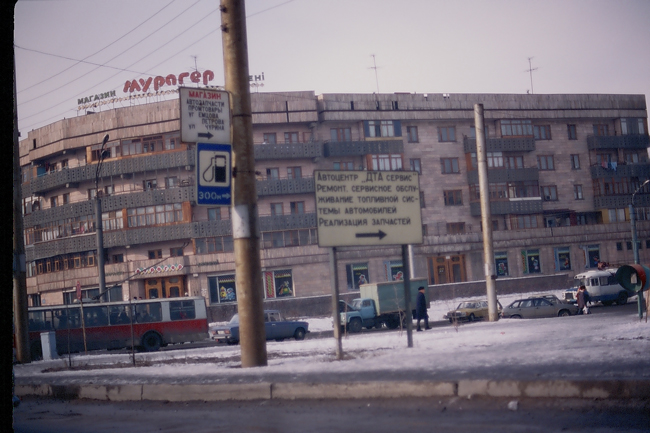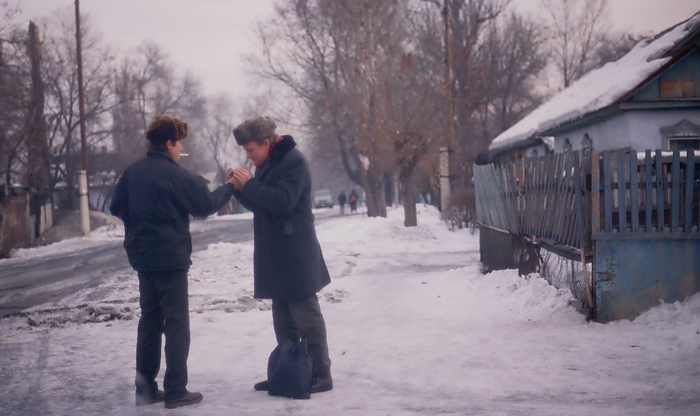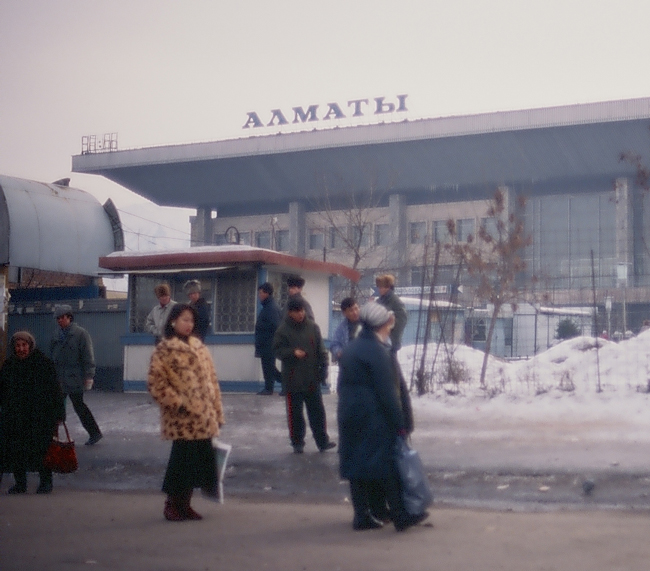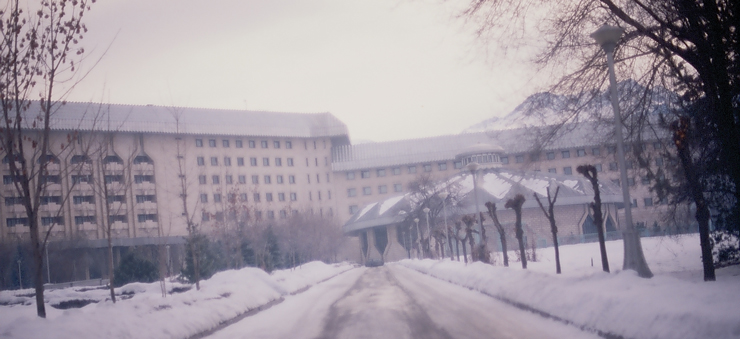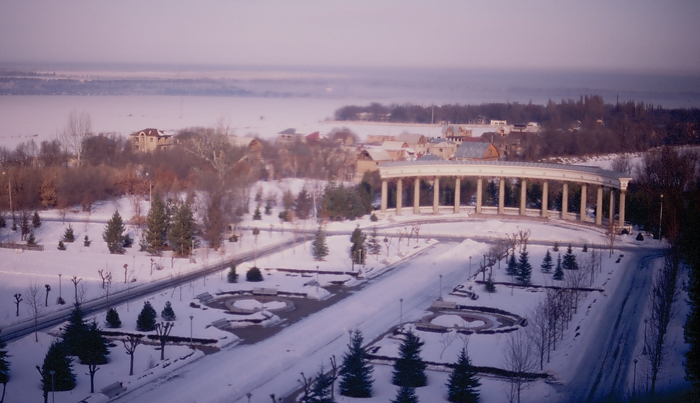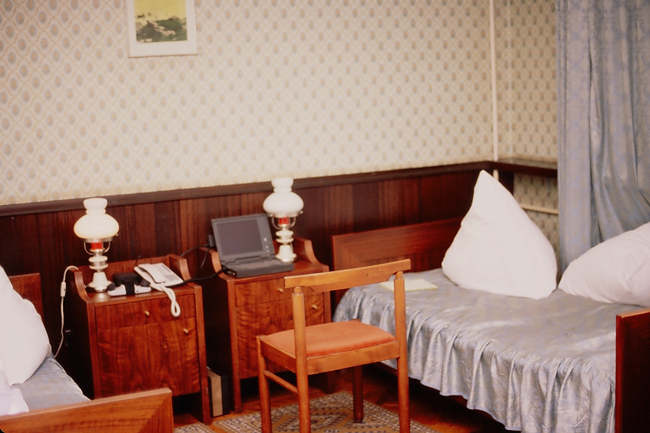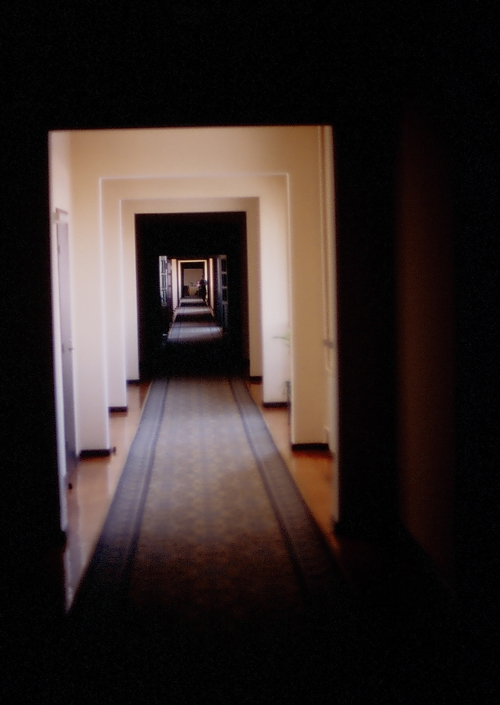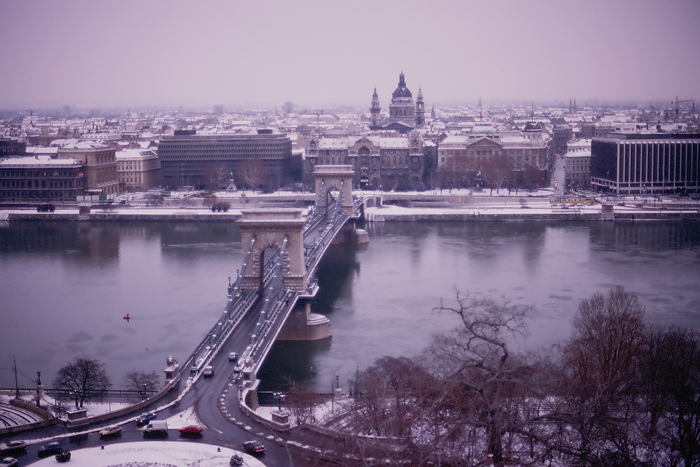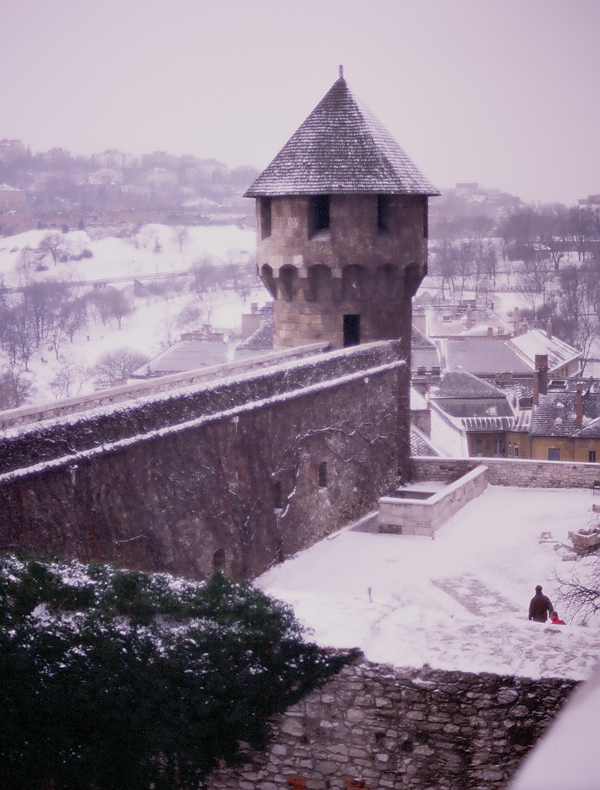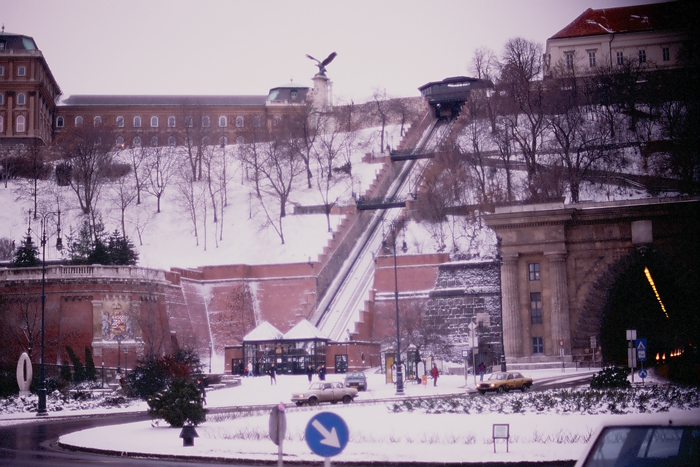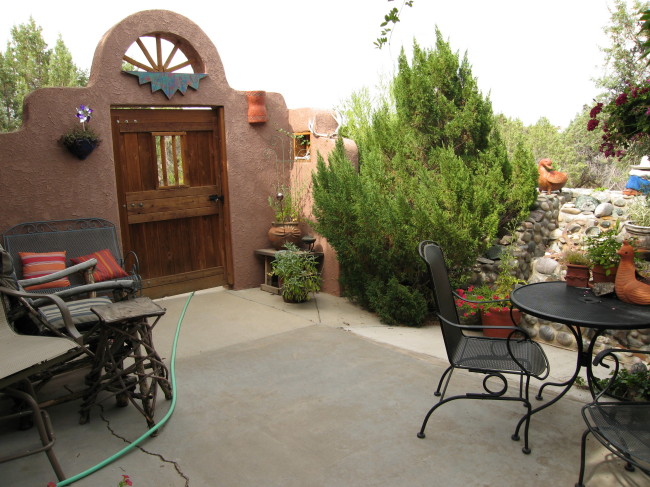|
The Uzen report was completed within a month due to Mike Adams' incredible organizational and efficiency skills. He was a firm believer in writing a detailed outline, then writing each element of the report once and moving on to the next until the report was complete. I lived the entire month of July 1993 in Calgary and worked out of the Adams, Pearson, and Associates’ office until the project was completed. During this time, I fell in love with Calgary and explored the paths, railways, and rivers, while all the time enjoying the delightful people. Just as the report was completed, Bob Pearson told me PanCanadian was in immediate need of a Geologist with Russian skills to evaluate a sub-salt Kazakhstan project and he gave me their contact information. He provided this information without asking for any percentage of my earnings, which was most kind. I contacted Michael Volcko at PanCanadian (now EnCana) immediately and started work for them a week later on a two-week project. The day rate was attractive and, unlike Questa, I was receiving 100% of the money (not 75%).
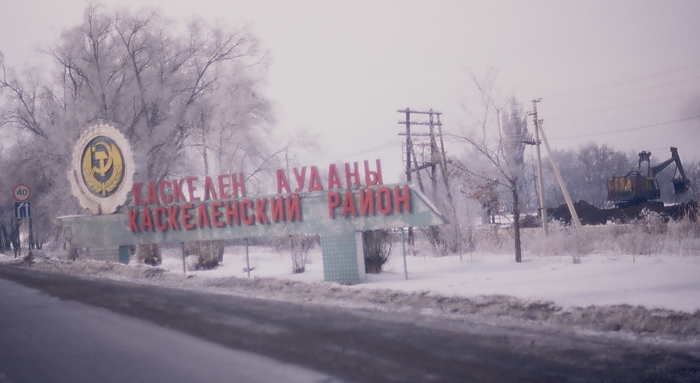 Road to Almaty from airport. The Novobogatinsk Field had a very short evaluation fuse and PanCanadian hadn't begun to sort out the stratigraphy when I arrived. I asked to use their conference room for an office and proceeded to put logs up all around the room as I attempted to correlate them. The correlations were quite difficult even for someone as seasoned as me, but after my fourth day, I finally cracked it and established field-wide correlations. PanCan needed economics completed by the next Friday for a management presentation and they had nothing completed yet. So my work was cut out for me.
I didn't have a geotech to help me, so I worked all weekend and managed to finish everything but the planimetering by Thursday morning when I learned PanCan wanted to make their own maps using their computer-mapping program, from which they would determine their own volumetrics. They were the client, so they did as they thought best. Late Thursday afternoon, they produced a spreadsheet with volumetrics for me to review, and I told them their results were wrong. The numbers made no sense. Their program blew up somewhere and they were hosed. As an alternative, I offered to hand-planimeter the data with my computerized planimeter and told them I could have results by 7:00PM that evening. I finished an hour early, the results made sense, and I earned a huge amount of credibility and good will; which, in the end, lead to a three-year retaining agreement with them. The final Novobogatinsk report wasn't formally completed until the end of August, so already I'd enjoyed a month of consulting with them. PanCan elected not to pursue Novobogatinsk, but wanted to present our study to the Kazakhs to establish credibility and, at the same time, seek other and better joint-venture opportunities in Kazakhstan. The Kazakhs already mentioned another possible JV field for PanCan to review called East Zhagabulak. I now had my foot in the PanCan door and they asked if I would accompany them on a data collection trip and help present the Novobogatinsk study.
 Michael, two Kazakh translators, and Bill Connelly. It wasn't until February 1994 that we finally arrived in Almaty, the capital of Kazakhstan. It's located in the far northeastern side of the country in a basin at the foot of the impressive Tao Mountains. The Tao Mountains are the first of several ranges separating Kazakhstan from China and reach over 6,000 meters elevations. The air in Almaty is the most polluted I've ever seen due to the tired old motor vehicles burning leaded gasoline, and the severe inversion trapping the exhaust in the basin.
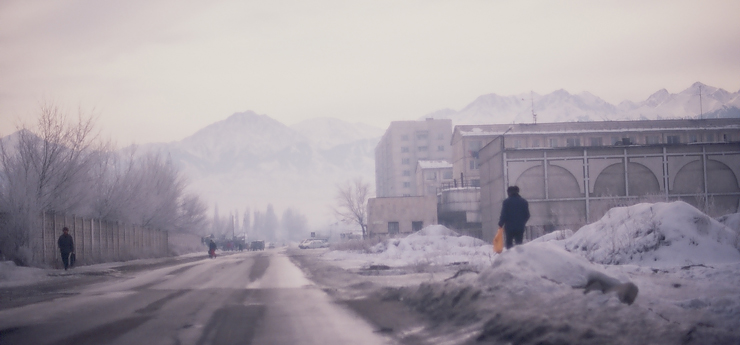 Approaching the city of Almaty.
We stayed at the Alatou sanitarium during this and other visits to Almaty. Alatou is an eight-story hotel with three large wings. It's an old Communist Party facility with hundreds of rooms plus a swimming pool, massage rooms, saunas, hair styling parlors, poolrooms, giant chessboards, and more. The hotel opens toward the Tao Mountains, which are quite beautiful with sharp icy crags and pine trees. Alatou is located 20 minutes from Almaty and the air is clean since it's above the inversion. Michael Volcko, Dave Klepacki, Michael Vaynshteyn, and I arranged to have massages, which turned out to be a mistake. The masseuse was a muscular white Russian woman with a scarf, and no oil. She was quite strong and rough, and when she was finished, there was a pile of my body hair next to her massage table.
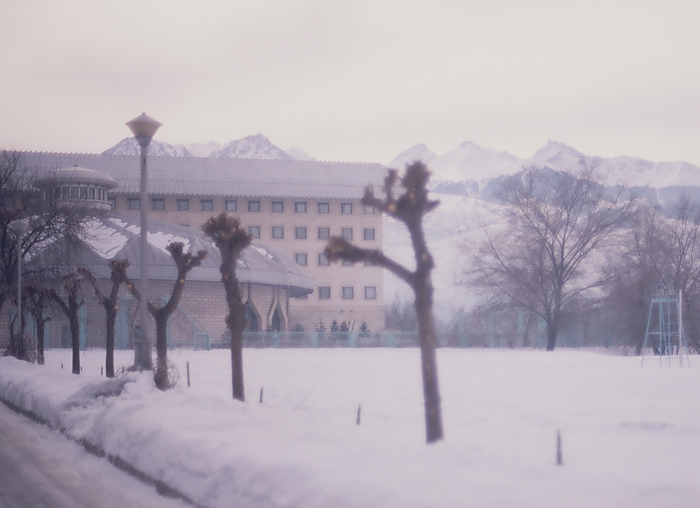 Front of Alatou Hotel, near Almaty.
Our presentation of the Novobogatinsk Field was in the afternoon and was a total waste of everyone's time since we expected nothing to come of it except to show the Kazakhs we had technical expertise. I presented all of the geology, Volkvo presented the engineering, and the presentation was finished in two hours. We were anxious to depart Almaty for Aqtobi (formerly Acktubinsk) where the real opportunities were anticipated.
 Buying gas in Almaty. To fly to Aqtobi, we chartered a YAK-40 which is a small twin engine jet built by the Russians in the 1970's. Under ideal conditions, it was a four-hour flight with one refueling stop, but there was a blizzard at the time. While we were delayed two days by the weather, I figured out how to send email to the family from Almaty. This was no small challenge and predates the Internet by many years. I had subscriptions to DunsMail and SprintMail because of PSI, but only SprintMail had an Almaty access dialup number. The connection was very noisy and dialing was only by pulse; no tone dialing. I brought an acoustic coupler to fasten directly to the phone receiver since the Russian wiring was not conducive to the usual alligator clip techniques I used in Europe. I would initiate the call on the computer with only the “ear” of the coupler connected so the computer would hear the dial tone and start its sequence. Then I would manually dial the phone number on the phone. When the connection was made, I quickly connected the “mouth” of the coupler and communication was established. Only 300 bauds were possible due to noise on the line, but I was pleased. PanCan was not able to contact their office at all, so I sent official faxes to their legal department with this archaic email. The flight from Almaty to Aqtobi was quite the adventure. After a two-hour flight to Zhezkazgan, we stopped to refuel the YAK-40. Zhezkazgan is located northeast of Baikonur (which was and continues to be the Russian space program headquarters), just outside the 100-kilometer no fly zone. It was -40 degrees when we landed and snow was blowing at 30 kilometers/hour down the tarmac. It didn't matter if it was Fahrenheit or Centigrade since at -40 Fahrenheit and Centigrade are the same bitter cold temperature. By the time the fuel tank was filled, the airplane wouldn't start due to the cold, but that didn't matter since we couldn't obtain clearance to take off anyway. We need to have clearance to land at Aktau and Aqtobi before we could take off and both were in blizzard conditions with less than 50 meters ground visibility. Zhezkazgon’s ground facilities were a military instillation and we went inside to get warm. We dressed for winter, but nobody anticipated hard conditions like this and we were seriously under dressed.
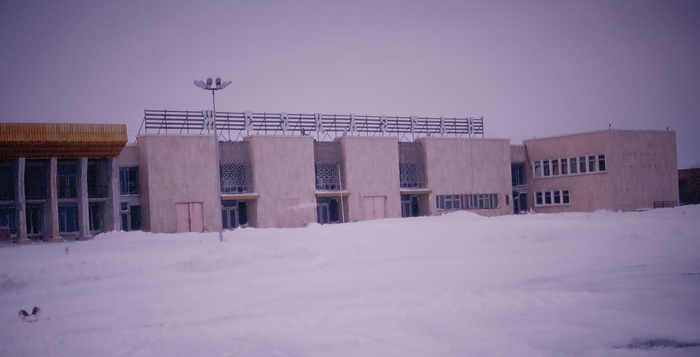 Zhezkazgan military airstrip. We were shocked at the antiquated electronics the military was using at the Zhezkazgan base, especially considering how close it was to Baikonur. The radios, radar, and other equipment were all using old tube technology. The weather forecast was coming to them every three hours on a one-meter wide radio facsimile that included the entire U.S.S.R., and there were large gaps in the data due to static. There was no phone available to call Aqtobi or Aktau to confirm whether they had the required 150 meters of ground visibility. Therefore we had to rely on a radio-teletype information. Think about that: a military installation with no phone. We ended up spending the night and most of the next day there waiting for a break in the weather and for adequate visibility according the radio-teletype messages which were updated every three hours. It was so cold, the water in the bathroom froze. At 22:00, we finally received word there was adequate visibility at Aqtobi and Aktau for us to take off, so we headed out on the tarmac to our plane. However it had been sitting in the blizzard for 38 hours and would not start. It was -36 degrees and the six of us huddled closely inside the fuselage to keep from freezing. A vehicle with a gas fired heater drove to the plane and ran two long one-foot diameter heating tubes to each jet turbine plus one to the fuselage. The plane then was heated to about 95 degrees trying to get the heat to permeate to the hydraulic lines in the walls. After about 20 minutes of heat, once again it got very cold. The pilots attempted to start the turbines, but no luck. So the heat truck again ran the hot tubes to the turbines and fuselage. When the jets finally fired, everyone shouted with joy. When we landed at Aqtobi, the hydraulic assist to the ailerons failed and the pilot, copilot, and mechanic all were manually pulling on the levers trying to land the plane. I gained a new appreciation for the cold from that trip. Aqtobi was very cold too, but there were buildings with heat and a place to sleep. I located the public phone building, but it was pathetic. Out of 16 phones in the local telephone/telegraph office for public use, only two “worked”. I am being generous in my usage of “worked”. I suppose when one these phones break there will be only one working. How could these people have been a nuclear threat such a short time before?! It scares me how close we may have come to war simply due to poor communications to and within the Soviet Union.
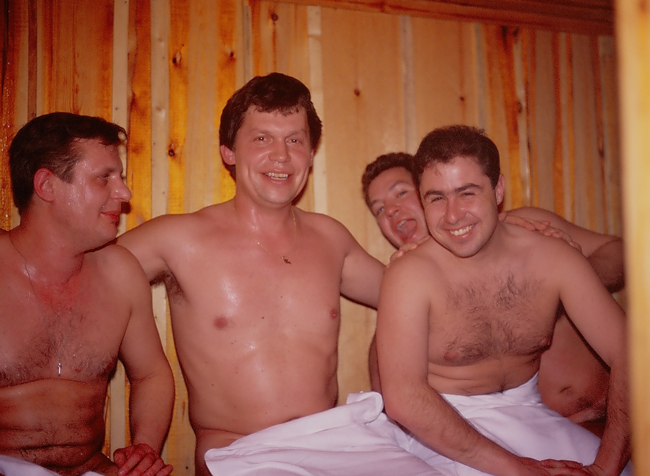 Several Kazakh colleagues in sauna with Michael Volcko (leaning). AktubinskNefteGas gave us a cold reception. On February 10, 1994, we set up the satellite phone we brought with us and made our first attempt to call the Free World, and it worked. It was great talking with Bernie and Serene and good to hear that all was well. [Our phone was a first-generation device and was packed in two very large chests: one for the electronics and one for the dish.] Zhagabulak Field had only two sub-salt wells. One well reached a total depth of 4,000 meters and tested relatively poor rates from the KT-I carbonates. The second well reached total depth of about 5,000 meters and tested oil in the KT-II carbonates. So what we really had was a one-well field with drilling depths of about 5,000 meters, 1% H2S, and sub-salt. The wells would cost about eight million dollars to drill. The pay in the KT-II was about 56 meters thick (making many assumptions regarding porosity which averaged about 8%). Seismic data showed east, west, and south closure, but no north closure. Either the seismic data had velocity problems masking the north closure, or it was a stratigraphic trap. We ran a risk model to determine reserves and estimated that the prospect contained about 35 million barrels of recoverable oil in the 12 square kilometer area. Putting your pencil to it, it amounted to more than $6/barrel recoverable to develop the field BEFORE taking into account the deal structure. Combined with the transportation fee of $3/barrel, the economics didn't make sense. Personally, I liked another field immediately to the east (upthrown on a high-angle reverse fault) called Alabulak.  Dave Klepacki coping data. The Kazakhs were pressuring us for an answer regarding PanCanadian's decision to purchase the data package over Zhagabulak. After some testy discussions, Mike finally told them that if they demanded an answer at that time, the answer was “no”. Aktubinskneft was interested only the $70,000 for the data package. They reminded me of the women on the street corners selling vodka and cigarettes for a small margin of profit. Rather than spending their idle time making something that could be sold, they settled for a tiny margin on vodka. I feel the professionals in Aktubinskneft were no different from the vodka salesmen on the road. PanCanadian was a company anxious to invest 100 million dollars on a 30-year project to produce Kazakh oil reserves, and they could think only about making $70,000 selling data over an uneconomic field. We broke the word to Kazakhs on Thursday morning that Zhagabulak did not meet PanCanadian's requirements. It was not well received. In addition, why would PanCanadian now spend $70,000 on data consisting of one useful well in a field it considered uneconomic? Therefore we moved on to plan B, which was to attempt to have a look at the Alabulak Field. It turned out that they did not control this field and it was committed to the Turks who were planning to build a power plant in return for Alabulak and two other fields. The only thing left they controlled were two supra-salt fields to the south. Karatube and Archar each covered only two to three square kilometers and were less than 2,000 meters deep. The oil gravity at Archar was too low to interest PanCanadian, which left Karatube. We were allowed to review the certification report of the two fields for about two hours before quitting for the day and I managed to capture most of the important data in my notes. Since the ‘next day’ and the ‘next hour’ often hold unexpected and unpleasant surprises in this business, it was my habit to ‘get while the getting is good’. We flew from Aqtobi to Aktyrou where PanCanadian had a tiny “office” (converted from an old apartment). This was the first of my many trips to Aktyrou. It's located on the north end of the Caspian Sea where the Ural River enters the Sea. The bridge over the river has a sign in the middle (in Russian) that read “Europe” on the west side and “Asia” on the east since the Ural River is considered the boundary between Europe and Asia. The river was frozen solid and one could easily walk across the ice. Several fishermen were on the ice in makeshift plastic huts with tiny fires keeping them warm while they fished for walleye for their families' dinners. We spent a few hours in the office, then tried to get a couple hours sleep in the bunk beds before catching a 04:00 flight to Budapest. The plane was Chevron's weekly charter for Hungarian oil-field workers at the giant Tengiz field and everyone was smoking and drunk. We really couldn't complain since we were lucky to get two seats on any plane. My intestines were growling at me during the flight, and obviously I’d been careless with the Kazak water and now had dysentery. The smoke and commotion exacerbated my dysentery and I thought the plane never would land. I don't know for certain where I got the bad water, but suppose it was either in the bathtub while washing my face in Aqtobi, or when scrubbing my teeth in Aktyrou. I always try to use water from the hot-water tap since I’ve been told that most micro-pests cannot survive hot-water-heater temperatures. But the hot water in the tub in Aqtobi was too hot and had to be mixed with some contaminated cold water. And in Aktyrou I brushed my teeth while still half asleep as we hastily prepared for a 04:00 departure. I thought I was using the hot water tap, but sometimes they plumb the sinks backwards and the water still was cold on both sides, so who knows. Then again it could have been the reconstituted juice served with most meals.
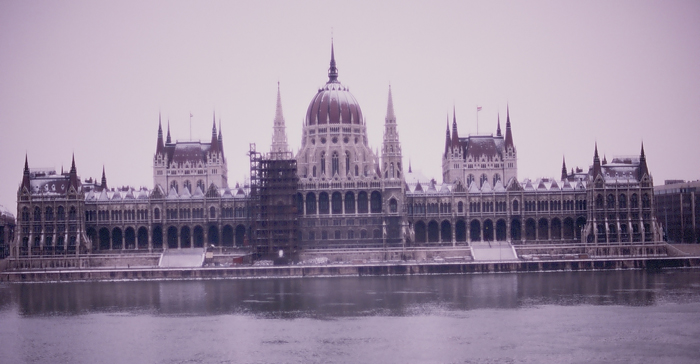 Budapest.
By 1998, the Former Soviet Union (FSU) lost its glitter and companies were winding down their efforts to put together joint ventures there. The Russians weren't reliable negotiators or businessmen and too often Western companies would spend months or years evaluating and negotiating a JV protocol with a Neftegaz only to have it slip away. Often the agreements would be signed, but the Deputy General with whom they were negotiating would be replaced and the new DG wouldn't honor the old agreement. So the process would begin anew with more new cars, offspring sent to American universities, hotels built, and outright bribes. On those few projects that were consummated, taxes and tariffs would be arbitrarily raised after-the-fact to reduce their profitability. So Western companies became wary of the FSU and looked for JV’s elsewhere in the world.
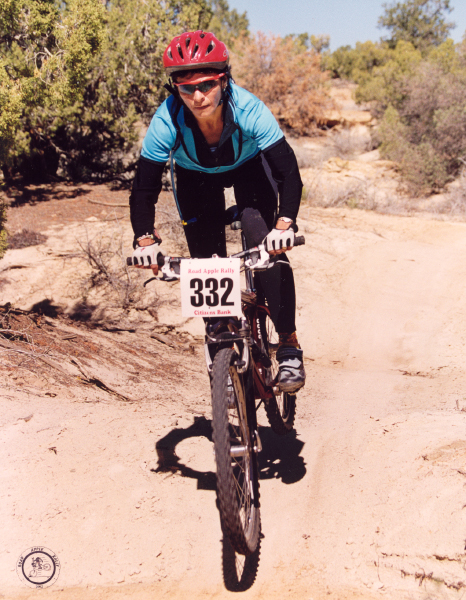  Bernadine and Bill Connelly, 2002 Road Apple Rally bike race, Farmington, NM. My consulting work was adversely impacted and I again needed to find new sources of income in this fickle oil and gas industry. My friend Ralph Nelms managed to land a good engineering job with Burlington Resources in Farmington New Mexico in early 1998, so I ask him for an introduction in hopes of obtaining work. My interview went well, but there was a hiring freeze in place at the time. They offered me a three-month consulting job to study the Cretaceous Tocito sand in the San Juan basin and I accepted. I hoped that would be enough time to demonstrate my skills to Burlington and at least extend my contract a few months, if not land a full-time job. At first, I was taken aback at Farmington. As I drove through town, I only saw the rundown buildings, dumpy house trailers, old houses with junk littering the yards, and wind-swept desert surrounding the town. Farmington was surrounded by Navajo reservation and located in the middle of a huge natural gas field. Most people were blue-collar oil-field workers and it seemed everyone drove pickup trucks.
Bill Connelly and Greg Howell building barriers to keep ATV's off Road Apple bike trail. As an avid cyclist, I stopped by Cottonwood Cycles and asked Ralph Wineburger (the owner) where there was good trail riding in the area and he directed me to the Road Apple trailhead at the top of Foothills Road. The trailhead was only 10 minutes away, so I went there planning to take a short ride. I ended up riding two hours. Alas, I was in mountain bike heaven with rolling hills and pinion and juniper forest that seemed to go forever. The snow covered San Juan Mountains of Durango Colorado seemed close enough to touch as I sped north along the trails. I was hooked. It was January 1999 and there was snow covering the ground in Golden, yet here cycling was fantastic. The elevation was 5400 feet and it was quiet and peaceful and this BLM land seemed endless. Yes, I wanted to live near this trailhead for a few years.

Bill Connelly, Dan Dunn, Bernadine Connelly, and Ralph Winebarger at Alien Run, NM.
Burlington liked my work and kept extending my contract and I kept driving back and forth between Farmington and Golden every other week when I had my Friday off (we were on a 9/80 schedule, so every other Friday was off). The drive took about seven hours and passed through the most beautiful part of the southern Rockies. I looked forward to the drive and listened to books-on-tapes as I sped along the back roads in all imaginable weather conditions. Considering my speed, I was fortunate to have only had one speeding ticket and one accident during my many trips. My Ford Explorer spun out on Wolf Creek Pass in a blizzard, but he damage wasn't bad and I finished the drive home (though it was cold with one window broken out). The twins were in their last year of high school and it was wonderful to see the family.

Bill and Bernadine Connelly, Jackrabbit Junction house, Farmington.
In February 2000, Burlington hired me full time, so we sold our house in Golden and moved everyone to Durango (except Sage, who was attending Colorado University in Boulder). The twins wanted to attend Fort Lewis College in Durango, so it made sense to live in Durango so they could live at home and pay in-state tuition. I commuted 50 minutes down to Farmington and it made for an interesting lifestyle. We ended up buying a second house in Durango for the twins. After a year, we sold the main Durango house and bought a house in Farmington on Jackrabbit Junction. This was a large Spanish style house on five acres located of dense pinion and juniper forest near the Road Apple trailhead. Bernie and I rode countless hours on the Road Apple trails during the years that followed and became accomplished cross-country racers. We entered most cross-country races in the Four Corner Region and placed in many of them.
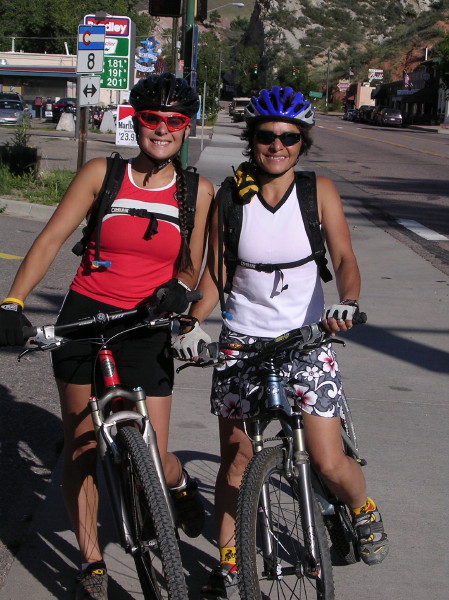 Sage and Bernadine Connelly, Doloras CO. Many times I would see a brown 1972 Oldsmobile parked at the Road Apple trailhead with senior man sitting in it waiting for a cyclist to return. Soon I realized the cyclist for whom he waited was a 12-year-old Navajo boy who I'd see riding the trails. He wasn't a good rider, but he was there nearly every day and developing rapidly. One day I introduced myself to him and his grandfather JT and learned his name was Sheldon Sandoval. He was a lean and shy boy and his grandfather was obese, but very friendly. After a time, I got to know Sheldon and rode with him more and more frequently. He came into puberty and grew tall and strong, and fast. The next year we entered many races together, both locally and in Moab. We enjoyed winning both the Junior and “old fart's” categories and bring metals back to Farmington.
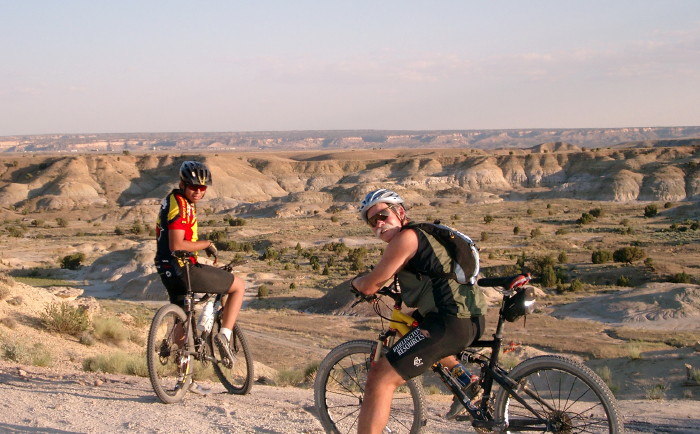 Sheldon Sandoval and Bill Connelly at Pinon Mesa.
Sheldon was given to his grandparents by his mother when he was only weeks old. The grandparents were poor but raised Sheldon in their old mobile home south of town. They were most grateful to me for taking him under my wing and entering so many bike races together. When I crashed hard while bike racing in the Cove reservation (Arizona) and broke my pelvis, the ambulance took me to the Navajo hospital in Shiprock. Several hours later, JT Sandoval drove to the Shiprock hospital from Cove to check on me and to drive me home to Farmington. It put tears in my eyes when I looked up and saw him next to my hospital bed. But Sheldon’s story didn't end well. A couple years later, he and a friend were caught in a stolen truck in Bloomfield and went to jail. He called me to bail him out since there were no resources for such things in this extended family. I bailed him out and hired him a lawyer and Bernie and I put him up in our house for a couple months trying to put him back on track. It didn't work out, and he slipped away from us. He married a lovely Navajo girl and they had a cute boy, then we lost contact when we went to Venezuela. I heard he continued to have run-ins with the law and never managed to go to college at Fort Lewis as I had encouraged. In 2002, I Founded and Directed a 100-mile road bike race from Colorado to New Mexico and back. The “Durango-100” starts and finishes in Durango and rides south along the Animas River to Farmington, then returns north along the La Plata River back to Durango. I raced in it four times and always finished in under five hours; several of the young racers finished under four hours. This event continues today and is celebrating its 12-year anniversary.
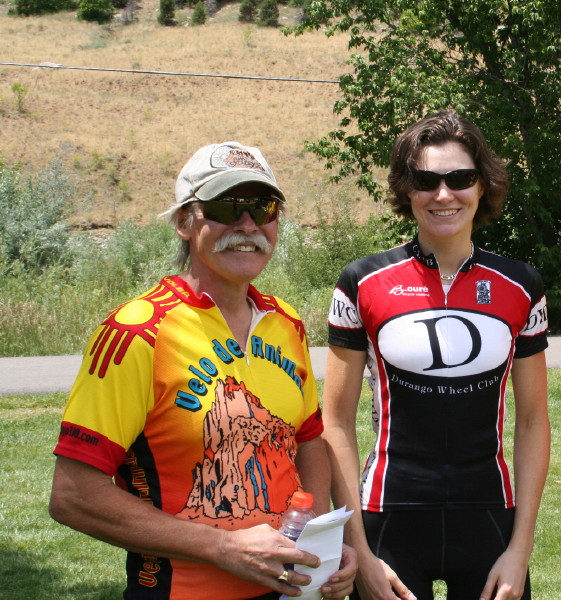
Most of my time at Burlington focused on the Mesaverde Group, which is one of the most prolific gas producing formations in the San Juan basin. I worked closely with a petrophysicist named Ralph Merry who taught me to use Geolog, which is a high-end petrophysics program. I built a huge digital well-log database with more than 3000 wells and used it to map the Mesaverde for the entire basin. I worked with Tom Loveland and Neil Roberts and completed a comprehensive resource assessment of the Mesaverde. It was an exciting project and the results were well received.
In 2006, Burlington Resources was acquired by ConocoPhillips and most professionals were offered lucrative retention bonuses for remaining with ConocoPhillips at least one year. In April when we were first allowed to apply for expat assignments with ConocoPhillips, I applied for and was accepted for a position with Petrozuata in Puerto La Cruz, Venezuela, and began my new assignment in the autumn.
|
